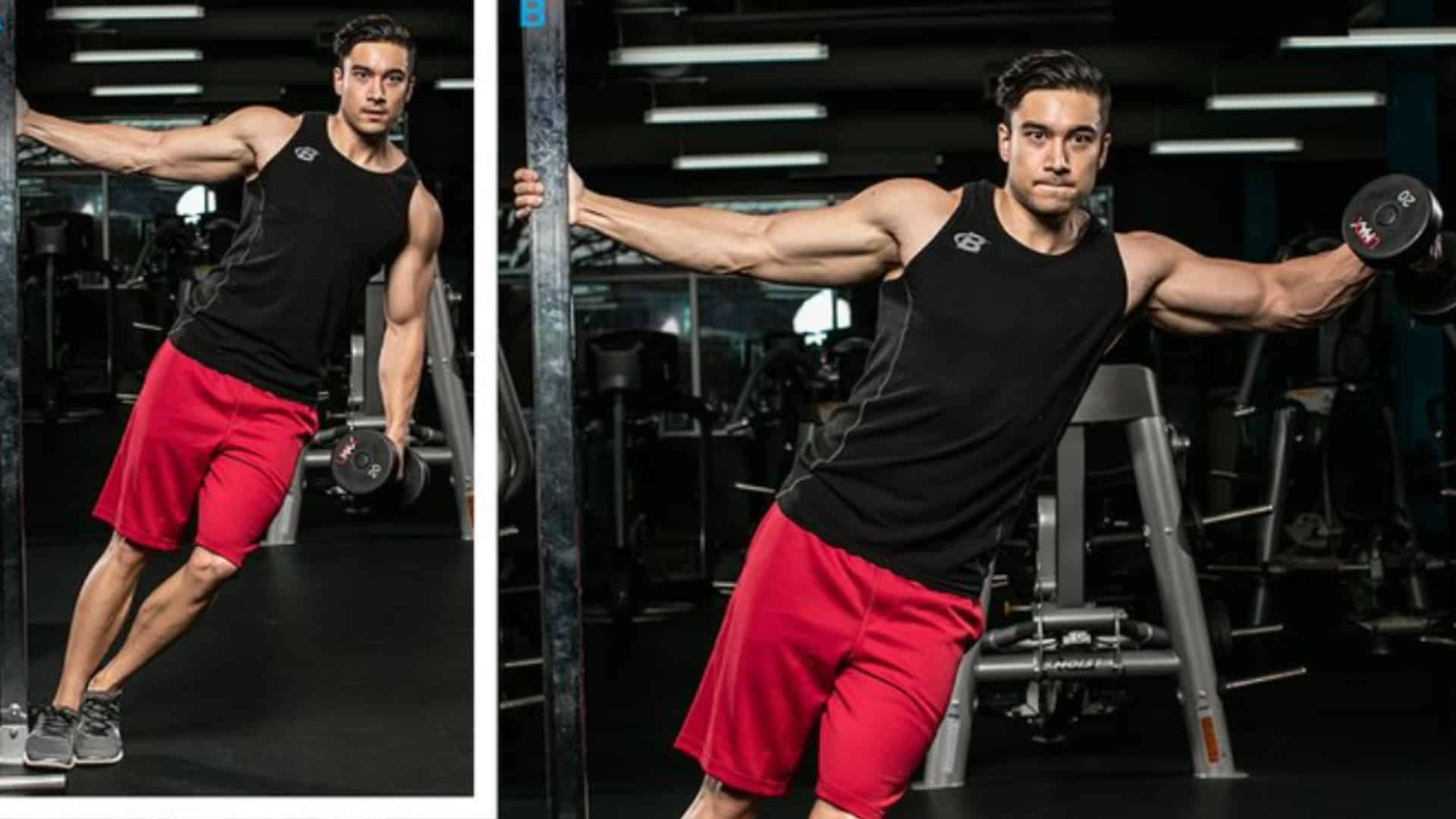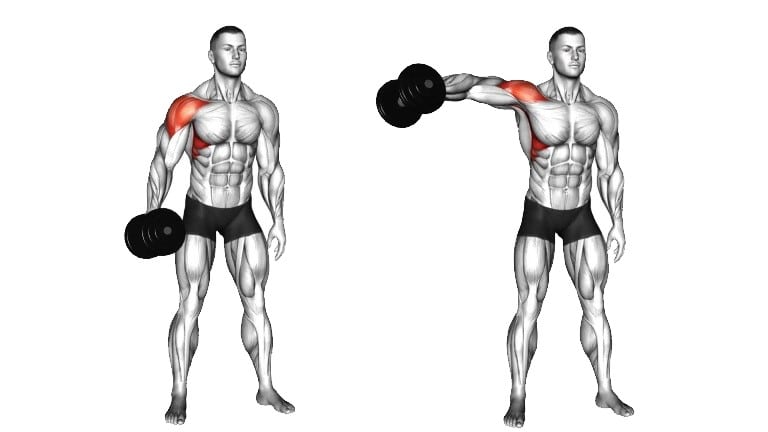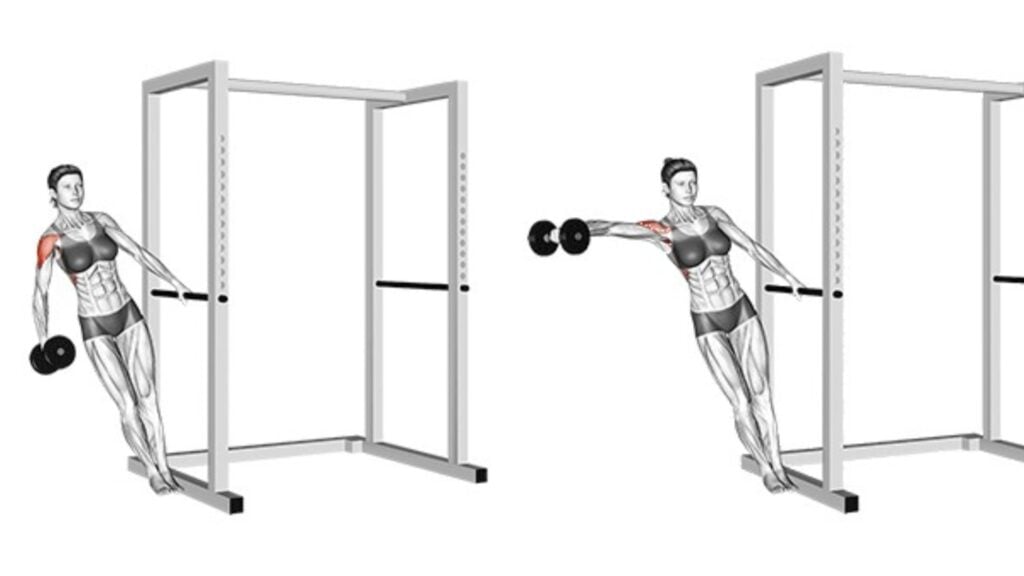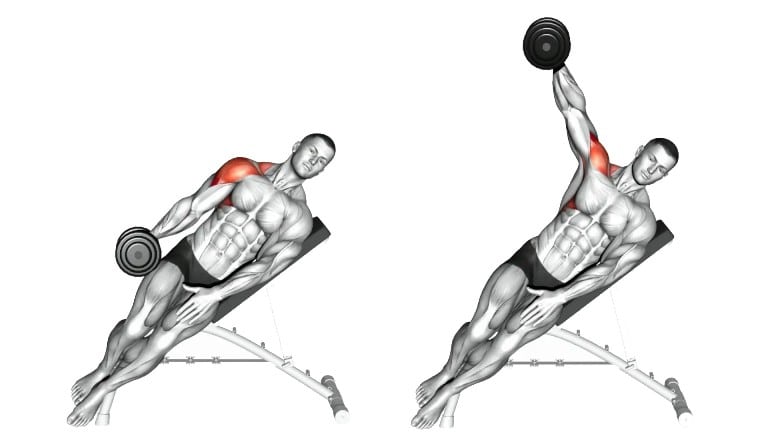The single-arm lateral raise is a variation of the lateral raise that helps build the shoulder muscles.
This isolation exercise blasts your side delts, helps correct muscle imbalances, and builds core stability.
You can do the lateral raise exercise with both arms, but it’s better to do it with just one arm. This will make your shoulder workout harder and help you get stronger.
You can do the single-arm lateral raise with dumbbells or cables.
In this blog, we’ll break down exactly which muscles it targets and give you pro tips for perfect form.

What is Single Arm Lateral Raise
The single-arm lateral raise is a variation of the lateral raise exercise that is performed with one arm at a time.
Basically, this move is all about targeting the side part of your shoulder muscles, called your lateral deltoids. You will need a dumbbell and a cable to raise it to the side.
A single arm at a time can help you focus better on the working muscle and can help identify and rectify muscle imbalances.
Muscles Worked During Single Arm Lateral Raise
The primary Muscle Worked during single-arm lateral raises is the lateral deltoid, which is the middle portion of the deltoid muscle.
Secondary Muscle Worked: The anterior deltoid, posterior deltoid, upper trap, supraspinatus (a rotator cuff muscle), and serratus anterior (muscles along your ribs under your armpit) also contribute to the movement.
A handful of other muscles worked or played the role of stabilizer muscles, including yours.
- Wrist flexors,
- Obliques, and
- Rectus abdominis.

One Arm Dumbbell Lateral Raise
One-arm dumbbell lateral raises are a fantastic and widely accessible way to target your shoulder muscles. It is an excellent exercise to isolate one side at a time and build side deltoids.
Dumbbells offer a natural range of motion and greater freedom to adjust your hand position (neutral grip, thumb down, etc) compared to fixed cable machines.
Make it a part of your dumbbell shoulder workouts to strengthen the lateral side of the deltoid muscle.

How To Do Dumbbell one-arm lateral raise
- Stand upright with a dumbbell in one hand. Keep the other hand free or on your hip.
- Your feet should be about shoulder-width apart with your back straight and core engaged.
- Now bend your elbow and raise the dumbbell to your side.
- Lift them to a point slightly higher than your shoulder.
- Now lower the dumbbell in a controlled manner back to the starting position.
- Perform all reps on one side and then repeat with the other arm.
Tips
- Pause momentarily at the top before slowly lowering the dumbbell back to the starting position.
- Keep a controlled motion and avoid jerky movements.
- Avoid arching of the lower back.
One Arm Cable Lateral Raise
One-arm cable lateral raises are the most popular shoulder exercise, designed to target the medial deltoid and contribute to a sought-after V-shaped upper body.
It provides constant tension on the target muscle group as you move the weight through the range of motion.
To make it more challenging, you can try Cross-body lateral raise. To do this, reach across your body with your opposite hand and grab the handle. Then, raise the handle out to the side until it is parallel to the ground.

How To Do One Arm Cable Lateral Raise
- Stand next to a cable pulley machine with your feet shoulder-width apart and the handle attachment adjusted to the lowest setting.
- To maintain good posture, push your chest forward and point your shoulders back while slightly bending both knees.
- Grab the handle and stand straight up with your arm fully extended and feet facing forward.
- Maintaining a slight bend in your working elbow, raise your arm up to shoulder height.
- Hold for a second, and then slowly lower the weight back to the starting position.
Tips
- Keep your torso still, your back straight, and your elbow slightly bent.
- Don’t just swing your arms. Keep controlled motion throughout the exercise.
- Always use weights that you can handle comfortably.
Know More: 14 Best Cable Chest Exercises and Workout Routine
Lying One Arm Dumbbell Lateral Raise
This exercise isolates the lateral deltoid muscle, similar to the standing or seated versions.
Lying on a bench eliminates the possibility of using body sway or momentum to help with the lift. This forces the target lateral shoulder muscle to do nearly all the work.
Lying side laterals is perhaps difficult for beginners, but it is an interesting variation on conventional lateral raises.

How To Do Lying One Arm Lateral Raise
- Lie sideways on a flat bench, propping yourself up onto your elbow so it is perpendicular to the bench.
- Hold the dumbbells so that they rest sideways on your upper thigh
- Slowly lift the dumbbells up and out to the sides of your body, pulling through the rear delts and middle traps.
- Pause a moment at the top of the motion before slowly lowering the weights back down to the starting position.
Tips
- Do not lift backward or forward.
- Avoid using momentum. Focus on moving in a slow and controlled fashion.
- Your working elbow should be slightly bent during the lift.
Leaning Single Arm Dumbbell Lateral Raise
Compared with the dumbbell lateral raise, the leaning dumbbell lateral raise puts your lateral deltoid under tension through a greater portion of the range of motion, making each repetition more effective.
The leaning position creates leverage while maximizing the isolation of the shoulders throughout the movement. It also places greater overload at the top of the movement.

How To Do Leaning Single Arm Dumbbell Lateral Raise
- Stand holding a dumbbell with one hand. Feet are shoulder-width apart and knees are slightly bent.
- Now bend your elbow and raise the dumbbell to your side.
- Lift them to a point slightly higher than your shoulder.
- Now lower the dumbbell in a controlled manner back to the starting position.
- Perform all reps on one side and then repeat with the other arm.
Tips
- Keep a controlled motion and avoid jerky movements.
- Avoid arching of the lower back.
Incline One Arm Lateral Raise
The incline one-arm lateral raise is a useful variation on the traditional lateral raise, providing subtle muscle alterations and extra stability.
Adding this to your routine offers a fresh way to stimulate shoulder muscles, help fight off plateaus, and keep your shoulder workouts engaging.

How To Do Incline Single Arm Lateral Raise
- Lie sideways on an incline bench, set at 55 degrees, with your armpit over the top of the bench.
- Hold the dumbbell so that it rests sideways on your upper thigh
- Keeping a slight bend in your elbow, raise the dumbbell out from your side until your elbow is in line with your shoulder.
- Pause a moment at the top of the motion before slowly lowering the weights back down to the starting position.
Tips
- Do not shrug your shoulders when raising the dumbbell.
- Avoid using momentum.
- Your working elbow should be slightly bent during the lift.
Best Alternatives of Single Arm Lateral Raise
Before we deep dive into the best one-arm lateral raise alternatives.
We must remember, a single-arm lateral raise alternative will be able to satisfy the following criteria:
- Activate the lateral head muscle, which is trained in single-arm lateral raise.
- Isolate the muscle groups during execution.
- Train the lateral deltoid muscle through a longer range of motion.
1. Dumbbell Lateral Raise
To build the lateral head of the deltoid muscle, make lateral raises a regular part of your shoulder workout.
It’s a suitable alternative to a single-arm lateral raise to build your lateral deltoid workout.
2. Cable Machine Y Raise
The cable Y-raise is a fantastic exercise for the whole shoulder that activates all fibers of the deltoid anterior, lateral, and posterior, but it mainly targets the lateral shoulder.
This lateral deltoid exercise is the best and most creative alternative to single-arm lateral raises.
3. Barbell Upright Row
While technically a compound movement, a wide grip upright row can provide a similar stimulus to the lateral deltoid.
Takeaways
Single-arm lateral raises are great exercises to give a balanced shape to your shoulders and make them look broader.
You can add the single-arm lateral raise to your shoulder workout routine as much as possible.
References:
- Coratella G, Tornatore G, Longo S, Esposito F, Cè E. An Electromyographic Analysis of Lateral Raise Variations and Frontal Raise in Competitive Bodybuilders. Int J Environ Res Public Health. 2020 Aug 19;17(17):6015. doi: 10.3390/ijerph17176015. PMID: 32824894; PMCID: PMC7503819.

Manish is a NASM-certified fitness and nutrition coach with over 10 years of experience in weight lifting and fat loss fitness coaching. He specializes in gym-based training and has a lot of knowledge about exercise, lifting technique, biomechanics, and more.
Through “Fit Life Regime,” he generously shares the insights he’s gained over a decade in the field. His goal is to equip others with the knowledge to start their own fitness journey.

